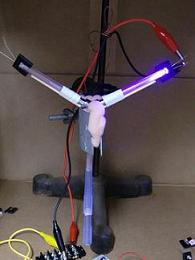Team:Kyoto/Capture
From 2011.igem.org
Contents |
Project Luminescence
The Phototaxis of Drosophila melanogaster against lights of different wavelengths from --nm to --nm and weak luminescence emitted by Luxbrick(BBa_K325909, iGEM Cambridge2010) were evaluated. Drosophila melanogaster was chosen as the object for our research because of its popularity among Japanese houses, facility or easiness to breed and genetical identity which results in the similar behavior. From the result of the research, Drosophila melanogaster was demonstrated to be a good ammoniacal source for genetically modified bacteria.
Introduction
In the nature, there are some organisms which lure insects. Rafflesia[http://en.wikipedia.org/wiki/Rafflesia] attracts flies by distinctive corrupt smell like rotting flesh. Pyrearinus termitilluminans, which makes and lives in a tunnel around the eternal surface of the anthill of termite Cornitermes cumulansand, emits light in the first week of the rainy season to lure and hunt the termites. Arachnocampa also uses light to hunt flies.
Escherichia coli is usually cultured in the rich nutrient medium because it originally lives in the gut of animals. However, this restriction can be cleared by the genetic engineering. For the first step to make E.coli autotrophic, we decided on the ammonia source. Many insects has some kind of taxis and this behavior can be made advance of to catch them. The taxis of moth toward pheromone is one of the famous example of chemotaxis, but it is difficult for E.coli to synthesize complex compounds like pheromone. Thus, we chose phototaxis, the simplest and most suitable method. Drosophila has been reported to have the phototaxis. Also, it is very popular among or around many households. Our project targeted at flies(Drosophila melanogaster) as the ideal ammoniacal source considering its popularity among Japanese houses, facility or easiness to breed and genetical identity which results in the similar behavior. We introduced to E.coli, the LuxBrick(BBa_K3225909) created by the iGEM 2010 Cambridge team to emit light in normal E. coli strains without the addition of any external substrate.
Although, it is well known that D. melanogaster is phototactic, it was not clear whether it is lured by the weak light especially emitted by E.coli. To confirm this, we first demonstrated the phototaxis with the Y maze experiment, with several LEDs. Y maze was put up vertically to gain the significant results employing the geotaxis of D. melanogaster.
目標:大腸菌を光らせ、その光にハエを寄せ付ける。
手法:まず、LEDの光に対するハエの走行性を観察。
水平面に垂直に立てた、Y字型のmazeにハエを雄雌別で5匹ずつ3分間走らせた。
LEDはmazeの二つのゴール地点のうち両方に設置した。そして片方だけ灯し、もう片方は無灯火にした状態でハエを投入した。
mazeを水平面に対して垂直にしたのは、ハエの走地性を利用して明確な実験結果を得るためである。
その観察結果から、確かに大腸菌から発せられる495nm付近の波長にハエは引きつけられることが確認できた。
2010年のCambridgeによる研究の手法を使い光る大腸菌を作り、その光にハエをひきつける。
Materials and Methods
1. Apparatus
Y maze
Y maze was constructed by a Y joint, 弁, straws and LEDs.弁 was made of a blue tip of pipetman and it had the function to prevent drosophilas to go backward. Straws and 弁 were fitted with the two terminals of Y joint by vinyl tape as figure.LEDs were fitted with the other terminals of the straws by 凹 parts made of polyethylene board. The angles of Y-form was 120°.
This Y maze is put into the dark room. (作成者:草場、未添削)
Y maze was constructed by the commonly available straws,__ , LEDs and __ to clamp LEDs. Straws were _色_ striped, in diameter and made of _. _ was made of metal, the angles of Y-form was _ in its top and _ in its side. LEDs were ,, and. __s were cut out of _ into re-entrant shape whose detailed dimension is described below in the figure. After preparing all in above they are connected together with tape and put into the dark room.
ここに装置全体の写真とイラストを載せる。
↑なし/ Diagrammatic representation of the Y maze equipment constructed from straws and __.
ここにLED固定用の装置の寸法を記したイラスト/写真を載せる
Pooter(吸虫管)
Straw was constructed by the commonly available straw, plastic tip and tissue. The tips were used as mouthpiece and objective end.
ここに装置全体の写真とイラスト(完成図と制作方法)を載せる。
↑なし/ Diagrammatic representation of the pooter constructed from a straw, pipets and tissue.
2. Object
Fly
The flies were derived on _日付_ August 2011 from the _strain_ of Drosophila melanogaster kept in _場所_. They were maintained in the temperature controlled incubator at _℃ with a _h light phase(LD 時間:時間) and cultured in the ordinary glass bottle (cm high, cm in diameter)with _培地の名前_medium. The medium was produced according to the method in http://. Every day, the newly born flies were transferred to another bottle to control the postnatal day. The population size of the flies were between _to_.
E.coli
strain, gene, culture method, etc.
3. Method
ハエオス/メス○匹ずつを吸虫管
Result
Discussion
Reference
1. Rafflesia. In Wikipedia Retrieved 6 September 2011 at 16:02., from http://en.wikipedia.org/wiki/Rafflesia[1](※引用の方法あってるのか自信がない)
 "
"










